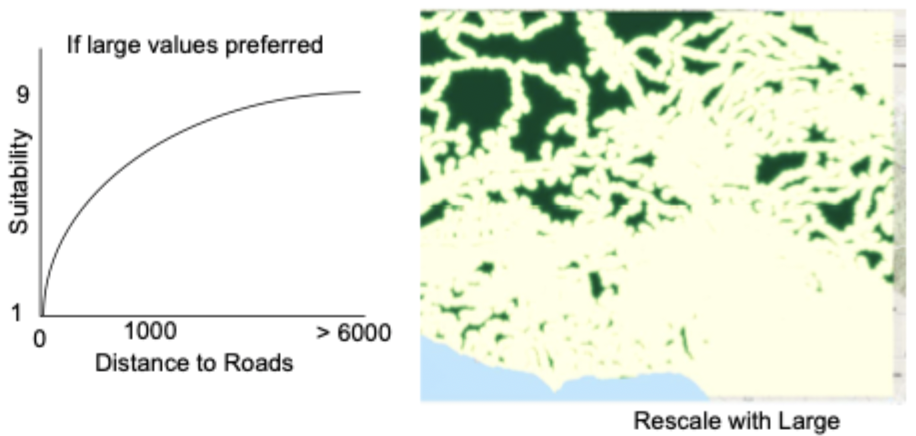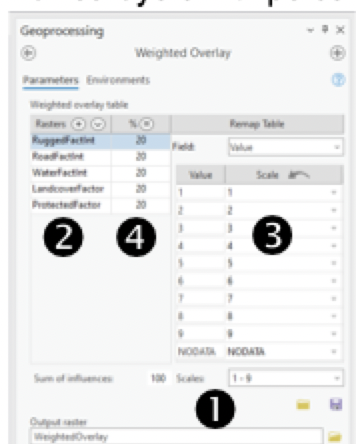Modeling with Rasters III: Weighted Overlay
1/20
There's no tags or description
Looks like no tags are added yet.
Name | Mastery | Learn | Test | Matching | Spaced |
|---|
No study sessions yet.
21 Terms
Data Transformation Approaches: Categories Approach
define a scale for suitability
Often scale from 1-9 is used
Reclassified to give relative suitability
use the same scale for all layers in a model
Data Transformation Approaches: Range of Values Approach- reclassify
Uses quantile: which will put the same number of pixels in each of the categories
If there are ties it will mean slight variation
Same data with equal interval
Will make a different
Lots of variability through amounts in each category
These may mean the 9 is completely eliminated in the final comparison
Can be exclusionary
Data Transformation Approaches: Mathematical Functions Approach - rescale by function
With distance variables we can use rescale by function
Large values more preferable than small ones max distance is just over 6000
Any thing greater than the midpoint has increasing preference
So greater than the 1000 is preferable
in image green is 8s and 9s: what it would look like if large values are prefered

What is a Decision Rule?
a method or logic used to combine multiple criteria
set constraints, combines, handle tradeoffs, rank alternatives
Weighted Sum Decision Rule
Certain layers will be more significant than others and are weighted(weight x layer) before they are combined
can apply weighted as a multiplier or as a percentage
multiplier- the scales of the suitability surface will provide. higher contrast between the scores of the most suitable locations
percentages- by applying weights as a percentage, the user defined suitability scale is maintained
Apply as a multipliers(most suitably location will be quite different in values than those that are not); if percentage is used(the original values will stay the same?)
To do this you can use..
The weighted sum tool and; or weighted overlay tool
Weighted Overlay Tool
Uses only integer data
So you may have to reclass rescaled data into integer rasters
Set scales
Add rasters
If they are already on their 1-9 scale you won't have to reorganize them
Then add the weight and run

Pros of Weighted Sum
handles continuous and integer
no need to rescales inputs
higher precision(floating point)
simple linear combination
Pros of Weighted Overlay
Standardizes different scales automatically
works will with categorical data
Scaled result: easy interpretation
Cons of Weighted Sum
no automatic rescaling
no built in handling of categorical data
hard to interpret results of scales mismatched
the decision rule:
highly sensitive to weights(though arbitrary and subjective)
weighted sum assumed linearity, not all relationships are linear
heavily dependent on the data transformation approach
Weighted Overlay
only supports integer data
less control over how rescaling works
can introduce bias if rescaling is poorly calibrated
Locating Regions
creation of candidate sites:
finding contiguous areas that meet the model goal
need to considers shape, size and other characteristics
size can specify:
total area you are interested in
minimum area
maximum area

Approaches to Weighting?
Either Ranking or Rating Methods
Ranking Methods
simplest method of all weighting techniques
every criterion under consideration is ranked in preference order
either straight rank(1 is most important) or inverse rank (1 is least important)
Once rank is established, several procedures are available for generating numerical weights from rank order informations
Types:
Ranks Sum
Ranks reciprocal
rank exponent

Advantages of Ranking Methods
simple(non complex calculations)
intuitive appeal(focus on relative importance rather than specific numeric values)
efficiency(useful where there is limited time, resources or data availability)
Low data requirements (rely on qualitative informations rather than extensive datasets or technical expertise)
Disadvantages of Rankling Methods
subjectivity- different decision makers may rank differently
loss of information -= only consider ordinal position of criteria
limited discriminations - limited to a small number of criterion
larger the number the harder to derive reliable ranking
Difficulty in handling ties - may require additional subjective judgment or arbitrary tie breaking rules
Rating Methods: Point Allocation
decision marker estimates weights on predetermined scale
each criteria would be allocated points with the total of all points = 100
the greater the points, the greater the relative strength of the criterion
Individual criterion$ can be normalized using: IMAGE
best one

Rating Methods: Ration Estimation Approach
Assign 100 to the more important criteria
Assign proportionally lower weights to criterion of less importance(in order of ranked positions)
Take ratio of each criterion to the least important criterion
Ratio expresses relative desirability of a change from the worst level to the best level
Weights are more normalized at the end by dividing each weight by the total of all weights
Advantages of Rating Methods
simplicity, intuitive appeal(like ranking approaches)
efficiency and low data requirements (like ranking approaches)
ease of aggregation of ratings from different decision makers that is another disadvantage of ranking methods
Disadvantages of Rating Methods
subjectivity- leads to inconsistency and variabilities in weights
difficulty in comparing dissimilar criteria
practically limited to small number or criteria
same issues arises in ranking too
Lack of consistency - without clear guidelines of how to assign points, decision makers struggle to maintain consistency
Whi is Better Ranking or Rating Methods?
both flawed, subjective, and lack mathematical rigor, but…
Rating is stronger theoretically
have quantification instead of ordinal ranking
mathematical transformations- can turn points to weights
statistical analysis- can be used to asses reliability